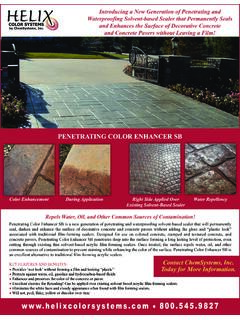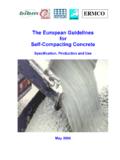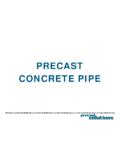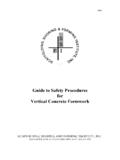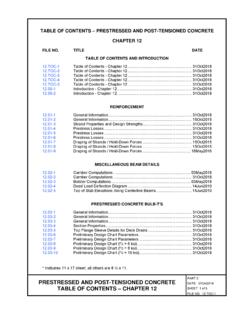Transcription of Guidelines for Exposed Aggregate Finishes 2015
1 GUIDELINE FOR Exposed Aggregate Finishes . Guidelines for a successful Exposed Aggregate finish on fresh concrete. This guide is for use by experienced concrete finishers, architects, owners, and new concrete contractors wanting to expand their work. Decorative Concrete Supply highly recommends that concrete finishers consider both ACI 640 & 601-D certification. Exposed Aggregate has been a popular technique with homeowners, architects and contractors for decades, although this look has been overtaken in popularity by new Finishes such as stamped, stenciled, colored and other types of decorative Finishes in recent years. Exposed Aggregate continues to offer a durable and aesthetically pleasing look for concrete. This method has withstood the test of time and has been successfully placed for over a century. New types of surface retardants allow for many varied looks, from deeper exposures to a light sandblast look. This provides a wide range of colorful looks and will help provide a slip resistant surface that is ideal for: Driveways Patios Walkways Pool decks Entryways and courtyards Tilt-up panels Exposure can be achieved in several looks Sandblast finish- Only sand is revealed Light Exposed finish- The edges and the very top of the Aggregate are revealed Medium Exposed - Finish where the Exposed rocks and cement are about 50/50 revealed Full Exposed - The Aggregate is revealed as the main part of concrete surface New types of surface retardants, which are more environmentally friendly, allow for several in-between looks, however depth should never exceed 1/3 of the diameter of the largest size Aggregate or the size of the smallest (ACI 303).
2 When picking surface retarders, it is recommended that you choose one that has a dye that can be seen to ensure even coverage. When using plastic, it is advisable to pre-roll the plastic on PVC pipes of the proper length. This will allow the plastic to be both placed and removed easier. Carefully read directions even if you have worked with Exposed concrete for years. Both gradation and soundness of aggregates selected cannot be over overstated. Avoid flat stones as they do not bond as well as round and cube sized aggregates. 8329 Monticello Road, Suite E, Shawnee, KS 66227 Tel: (913) 422-4443 Fax: (913) 422-8882. Website: Email: PLACEMENT OPTIONS. Three methods of Exposed have been successfully used over several decades: seeding the pre-picked Aggregate , mixed in a ready mix truck or Exposed later by mechanical means. 1) Seeding the pre-picked Aggregate -- the Aggregate is stock piled at the job site and broadcast into the fresh concrete.
3 Experienced concrete finishers should be used to seed. Seeding can be accomplished by using a shovel (a square point shovel offers the most even approach). Use of seeding by hand methods can also be used. This method is best done along hard to reach areas like walls and some edges. New mechanical methods can also be effective. Coverage can vary depending upon Aggregate size. Smaller sized stones will yield approximately 2 1/2 . 3 1/2 lb per/sf. Larger sizes may require up to 6 lb/per /sf or more. It is very important to carefully weigh and measure forms and have an ample supply on site during the pour. If a mechanical method is used, the material should be stored where it will be easy to re-load the spreader. When the seeding method is being used, the base course of the concrete mix should have aggregates of 3/8 to 5/8 diameter, but don't exceed 3/4 as this can make it more difficult to seed in the Aggregate . When seeding, it is critical that the finishers have proper access as well as the experience to provide an even broadcast.
4 Care needs to be taken with heavily cast areas as not to clump . which could result in a birdbath. Concrete mix designs for freeze/thaw areas should contain 6-8% of an air entraining admixture. These mixes not only help in harsh climates, but can improve workability and reduce bleeding of the concrete mix PLACEMENT METHODS FOR Exposed SEEDING METHODS. Check forms and screeds before placement begins and ensure sub grade is firm and properly compacted. Once Aggregate is properly seeded it will need to be worked into the fresh concrete paste. Time is of the essence in this critical step. The slab is screeded off in the same manner as normal concrete. Leaving the concrete 1/8-3/8 low in the seeding is fine as the Aggregate will increase the thickness at the surface. The concrete is then smoothed with wood Darby's and bull floats. Wood is the recommended choice for the initial finish. NOTE: the larger the Aggregate size in the seeding method, the deeper the concrete level should be below the form.
5 The forms should be set so that the final slab will be both drained well and level. The seeding or broadcasting can usually begin right after the final initial bull float application. The Aggregate is then uniformly broadcast onto the concrete surface. The Aggregate is then worked into the concrete surface. This may be done by screeding with a sawing motion, use of tamping tools or Darby's, and bull floats. Some newer type roller screeds are effective, but when using this method, concrete needs to be 1/8-3/8 inch lower than the forms. When this is accomplished, a final pass is made with the bull float to ensure 100% paste coverage over the embedded Aggregate . About 1/16th of an inch is needed. Magnesium and aluminum tools work well for the final pass. Avoid overworking the surface, as this may work the coarse Aggregate into the concrete too deep. Small amounts of water may be added during placement, however if color is used in the mix, all water must be added before placement begins.
6 For large pours, with or without color, consider use of set delays instead of adding water. 2) Mixed in a ready mix --many ready mix suppliers now stock Aggregate for Exposed concrete. It may increase costs as the Aggregate is throughout the entire pour. These costs may or may not be offset with reduced labor. With this method, there is no need to adjust the forms or grade as with the seeding method. PLACEMENT METHODS FOR MIXED IN A READY MIX. Place the concrete as normal. Preparation of sub grade and strike off methods are the same, however, aluminum or magnesium tools will work fine for use after concrete is screeded. 8329 Monticello Road, Suite E, Shawnee, KS 66227 Tel: (913) 422-4443 Fax: (913) 422-8882. Website: Email: Careful screed operations are vital to control any birdbaths or low spots. Be sure that edges are properly leveled. It might be necessary to sprinkle extra concrete along edges so that they are level with the forms.
7 This is done after the concrete has been screeded and floated. Avoid excess bull float lines and overworking the surface, especially on air entrained mixes. Be sure slumps do not exceed 5 inches and do not use jitterbugs or tamping tools. Concrete should be placed on a firm, compacted sub grade of uniform bearing capacity. It should be evenly graded and any lines should have a minimum of 2 inches of compacted fill. When no damage will be done to the concrete surface, apply the concrete surface retardant according to the manufacturer directions. This is especially true in non air-entrained mixes where there is usually more bleed water. Avoid pouring on wet/frozen sub grade and do not pour if rain is forecast within 8 hours of placement. FULL DEPTH POURS WITH SAND Finishes . New advances in surface retardants allow for placement of concrete with a sand Exposed look. Finishing is different than normal procedures. Use of a roller bug is done after initial bull floating, followed by a light trowel finish and then the retardant is applied and washing as normal.
8 Only the sand will be Exposed when done. Trowel only enough to provide a smooth surface, using a steel Fresno trowel. This does not require a hard troweled surface. This method can produce a slip resistant surface and may be integrally colored at placement or stained after curing. Be sure the surface retarders are applied evenly with uniform coverage. Keep an extra sprayer and have spare parts. Pick a quality sprayer as cheap sprayers can ruin a job. Carefully read directions from the manufacturer on timing for washing and how long the set is delayed. Temperature may have a great effect on the set time. Check water source and pressure before placement begins and be sure to have enough hose to reach the entire area. Never use jitterbugs when Aggregate is going to be Exposed , however use of a roller bug is recommended when a light sand Exposed look is done. Avoid pours when rain is forecast within 8 hours after placement WASHING OF Exposed CONCRETE.
9 The washing phase is very important as this determines the look of the concrete. The timing needs to be precise with the initial set and the length of time that the retardant works. A good rule of thumb for when to start is when the concrete finisher can be on knee boards without making an indentation. The workers can then begin to use a stiff bristle broom and remove some dry paste. When this has been done, the concrete can be brushed and lightly scrubbed with water using a softer broom. This will take a few passes. Be sure to keep a light mist to begin, and avoid power washers. Some brooms come equipped with water jets to aid in removal. If there are areas where the paste is hard to remove, it may be necessary to use a stiffer broom. This procedure should continue until the Aggregate has a uniform look, the water is clear, and all unwanted paste is removed. This will normally take several passes depending on the size of the concrete slab and the degree of exposure desired.
10 If aggregates start to become loose and pop out. Stop and wait for the concrete to become more firm. Use of low pressure washers or power washers is never recommended. Exposing of Aggregate typically works best with 2-3 man crews. ACID WASHING WHEN CLEANING. It has often been a practice to use a mild solution of acid to aid in the breakdown of the paste. If this method is used, it should be done before the sealing application, which is usually 14-28 days. Utilize a solution of 10-15 parts water to 1 part acid. Apply while the concrete is damp. Use of a plastic type watering can has been a successful method. Never use metal cans. Work the solution in with an acid resistant broom and rinse completely clean. Care needs to be taken not to overdose the acid as this can have adverse effects on the alkalinity of the concrete. Always wear protective boots, gloves, and protect Exposed skin and eyes from the acid. 8329 Monticello Road, Suite E, Shawnee, KS 66227 Tel: (913) 422-4443 Fax: (913) 422-8882.




